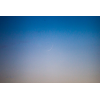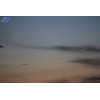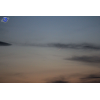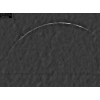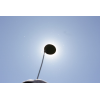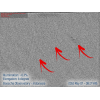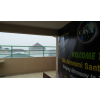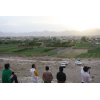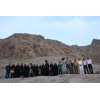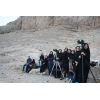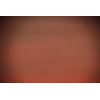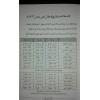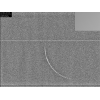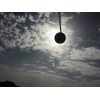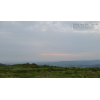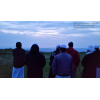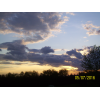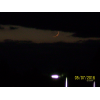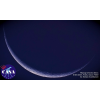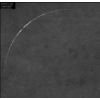Visibility of Sha'ban Crescent 1437 AH
- When to Observe Sha'ban Waxing (NEW) Crescent ?
- Sha'ban Waxing (NEW) Crescent Observation Results
- The OFFICIAL First Day in Different Countries
- When to Observe Rajab Waning (OLD) Crescent ?
- Rajab Waning (OLD) Crescent Observation Results
When to Observe Sha'ban Waxing (NEW) Crescent ?
The geocentric conjunction (Geocentric New Moon) will occur Inshalla on (Friday 06 May 2016) at 19:29 UT.
Sighting the new crescent on (Friday 06 May 2016) and (Saturday 7 May 2016) is shown in the below graphs using the program Accurate Times by Mohammad Odeh according to Odeh criterion. Where:-
- It is impossible to see the crescent from the areas located under the red color. Because either the Moon on this day sets before the Sunset and/or the topocentric conjunction occurs after the Sunset.
- The crescent is expected to be seen by optical aid only from the areas located under the blue color.
- The crescent is expected to be seen by optical aid from the areas located under the magenta color. In these areas the crescent could be seen by naked eye if the atmospheric conditions are superb and the observer is experienced.
- The crescent is expected to be easily visible by naked eye from the areas located under the green color.
- The crescent cannot be seen from uncolored areas, even though the Moon sets in these locations after the Sunset and the topocentric conjunction occurs before the Sunset, but the Moon is not sufficiently illuminated in order to be seen as crescent even by optical aid.
- Kindly notice that the below graph shows the possibility of seeing the crescent from areas between 60 degrees north of Equator down to 60 degrees south of Equator.
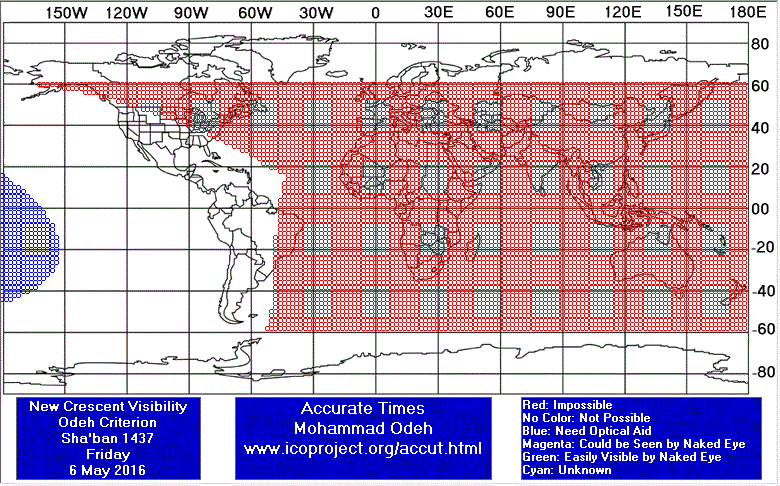
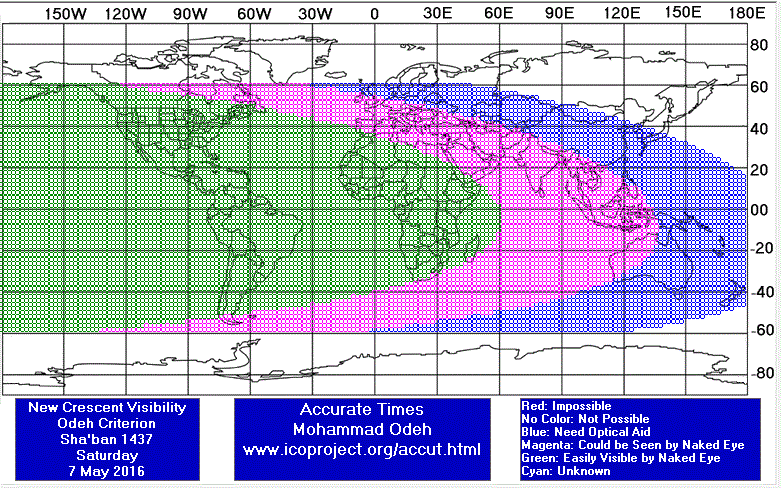
According to the Universal Hejric Calendar (UHC), which is based on the calculated crescent visibility, the start of this month in the Eastern Region will be on Sunday 08 May 2016 and in the Western Region will be on Sunday 08 May 2016. Kindly notice that the UHC is a pre-calculated calendar, which adopts a certain criterion to start the new Hejric month. Your country/organization might adopt different criterion to start the new Hejric month. So it is highly advised to read the UHC website before giving any judgment.
- Results of seeing the crescent, and the first day of the month in different countries will be added here Inshalla as we receive the reports from ICOP's members. If you wish to be a member in ICOP, or to know more about it, kindly click here.
Sha'ban Waxing (NEW) Crescent Observation Results
Sat 07 May 2016
Algeria
Mr. Hocine Chikh Aissa said: "We are 19 people, have attempted to sight the crescent moon (Hilal) of Shaaban 1437, We arrived at our sighting location N’tissa station before sunset. The western horizon was Clear. Using a pair of binoculars (7X50), We are sighted the Crescent with binoculars and naked eye At 19:44 the crescent elevation was about 8 degrees. We left at 19:19 when the moon was still about 3 degrees above the horizon. "
Dr. Abdallah Ouragh said: "تم بفضل الله عز وجل رصد هلال بداية شهر شعبان 1437 هـ من طرف أعضاء "جمعية القطب لعلم الفلك وتقنيات الفضاء" مساء هذا اليوم السبت 07 مايو 2016 م، وتمت أول ملاحظة للهلال على الساعة 19:47 أي بعد "16 دقيقة" من غروب الشمس الذي كان على الساعة 19:31 بالتوقيت المحلي. معلومات الهلال: مكان الرصد: "مرصد القطب" طريق الشيخ عامر - لروي."
Australia
France
Mr. Farid Fofana said: "لمزيد من المعلومات والصور، يرجى زيارة الموقع www.olmf.fr"
Germany
Eng. Martin Elsaesser said: "After seeing the crescent around noon with a good telescope and excellent conditions i could also observe it in the evening after sunset. The sky near the horizon was not good enough to see it with the naked eye but with 10x50 binoculars it was very easy. "
Eng. Martin Elsaesser said: "I first observed the lunar crescent in daytime around 11:30 local. The sky conditions were excellent and i could actually see the crescent visually through an optimized telescope at 30x and 50x. Elongation was around 10° and the crescent was 15.5hours old. The imaging system had no problem at all to capture this. There was a huge amount of pollen flying across the sky, far more visible than the crescent. Around 11:45 local the International Space Station passed in front of the crescent! I had only learned of this 15 minutes before but could still capture a nice video showing the crescent, the ISS and the pollen. https://youtu.be/zmap8GMEbDY I will also try to observe the crescent after sunset later today. "
Hungary
Indonesia
Mr. AR Sugeng Riyadi said: "The daytime new crescent of Sya'ban 1437 AH was seen by my friend (Muhammad Yusuf) from Bosscha Observatory, Lembang Bandung West Java Indonesia."
Mr. AR Sugeng Riyadi said: "The new crescent of Sya'ban 1437 AH was not seen from Assalaam Observatory, PPMI Assalaam Pabelan Kartasura Sukoharjo Central Java Indonesia. The sky was totally cloudy and was rainy before sunset. We were the members of CASA, also from SMAN4 Surakarta, Imam Shuhodo Boarding School, Al-Mukmin Ngruki, and Al-Barokah tried to abserve the moon, but no body could see the new crescent of Sya'ban 1437 AH. The team of BMKG at Gowa, reported that the new crescent was seen by telescope."
Iran
Mr. Hossein Janghorbani said: "In the name of God Shaban Crescent Observation Report Astronomy and Geophysics Center of Shahreza – The Crescent Association of Shahreza Report by: Hossein Janghorbani (Najmosepehr-Sadrolmonajemin) – Manager of Shahreza Crescent Association and Red Crescent’s Astronomy and Geophysics Center Date: Saturday, 5/7/2016 Location: Damzad foothills in the East of Shahreza (latitude: 32 00 N, longitude: 51 52 E, elevation: 1825m from sea level, time zone: +4.5 GMT) Equipments: two set of 15*70 binoculars , two set of 20*90 binoculars , one set of 25*100 binoculars, one compass. Atmospheric condition: partly cloudy. Horizon obstacles: about 2° Apparent sunset: --:-- Results: Moon crescent was not seen. Observers : 1.Abdol Reza Gholami 2.Mohmmad Karim Babarabee 3.Daryush Janghorbani 4.Mohammad Hossein Shahcheraghi 5.Reza Moslehi 6.Milad Eslami 7.Sayed Farzad Alavi 8.Mohammad Javad Nikeghbal 9.Ali Janghorbani 10.Hossein Janghorbani 11.Azam Erfan 12.Talaat Taheri 13.Ziba Hafar 14.Masomeh Hafar 15.Shiva Ansaripoor 16.Zahra Farrokhpoor 17.Tayebeh Shafiee 18.Reyhaneh Dadvand 19.Roya Ghermezi 20.Zinat Ghermezi 21.Soheyla Eslami 22.Narges Shahnazari 23.Zahra Fallahi "
Libya
Eng. Mohamed Mogerby said: "كانت السماء مليئة بالغباء والرياح قوية مما حال دون رؤية الهلال"
Malaysia
Mr. Agku Bolkhizan Ahmad Thani said: "Observer Name: Awangku Bolkhizan Awang Ahmad Thani Month Name: Sha'ban 1437 H. Location: Sungai Lada, Labuan FT, Malaysia. Longitude: 115.17 E. Latitude: 05.30 N. Elevation: 1m. Telescope: Celestron SLT90 f/8 Schmidt Cassegrain. Camera Model: Canon EOS 70D. Shooting Date: 07 July 2016 CE. Shooting Time: 18:45 (UT+8). Shooting Mode: Manual Exposure. Shutter Speed: 1/6 seconds. ISO Speed: 800. Temperature: 29 C. Atmospheric Pressure: 1014 mb. Topocentric Age (At Photo Time): 15 hours and 43 minutes. Geocentric Age (At Photo Time): 14 hours and 54 minutes. Lag Time: 37 minutes."
Morocco
Dr. Hassan Talibi said: "تعرف معظم مناطق المغرب اضطرابات جوية اليوم 29 رجب، أما الحسابات الفلكية فهي تشير إلى إمكانية رؤية الهلال كما توضح الوثيقة المرفقة، ولحد كتابة هذه الأسطر لم تعلن وزارة الأوقاف عن نتيجة الرؤية الشرعية التي غالبا أنها ستححق في المناطق الشرقية والجنوبية البعية عن الاضطرابات الجوية لأن معطيات الرؤية متوفرة"
Oman
Prof. Mohammed Al-Bussaidi said: "The western sky was hazy and partly cloudy. The Crescent was observed by using a CCD camera."
Saudi Arabia
Mr. Turki Alamri said: "since early morning me and Dr khaled alzaaq tried to capture the new crescent but clouds are present and haze AOD =0.3 the same condition continue to 4 pm Lt ,all the western horizon were blocked by clouds finally. "
Eng. Muflih Arisa Adnan said: "The west sky was hazy, even the sun could not be seen by naked eye. "
Sri Lanka
Mr. Abdul Rahman Razeen said: "Aalaikum. Today 7-5-2016AD=29-7-1437AH is the sighting day for the month of Shaban.. I was in Mullaitivu N.east of Srilanka.The co-ordination of the location is Lat;9deg18' Lon:80deg48'. Sun set:6.18pm. Moon set:7.01pm.The parameters are Lag=43minutes, R.Azimuth=-03deg07', Altitude=08deg54', Elongation=10deg18'. The prediction of the astronomers=Naked eye sighting will be possible by an experienced observer if the atmospheric conditions are favorable for sighting. The crescent was not sighted in any parts of Srilanka due to unfavorable weather conditions.I organized a sighting group at a place called "panivayal", Depo Road, Mullaitivu. I was there with Moulavi Fareed,Moulavi Adil and Moulavi Mujeeb.We also could not sight it due to unfavorable weather conditions. Hence it was decided to end the proceeding month 30day's and to start the month of Shaban on 9-5-2016 by the president C.G.M.H.C. M.Riyadh (Baari) along with A.C.J.U.and M.R.C.A. The day for "Nisfu Shaban" will fall on 23-5-2016 and the sighting day for the month of Ramadan will fall on Monday 6-6-2016"
Tanzania
Mr. Zaffar Sheriff said: "The crescent was earlier seen by binoculars, and later was confirmed by naked eyes at 6.36pm"
Tunisia
Mr. AlTayyeb AlSahili said: "إدخال شهر رجب من أصله خاطئ فالصحيح الثابت علميا وشرعيا أن يوم السبت 7 ماي 2016 هو اليوم الموافق 29 شعبان 1437 ------------------------- . كما ترون الرؤية مستحيلة تماما ليلة الجمعة ( عند غروب شمس يوم الخميس 7 أفريل 2016 ) . فيكون يوم السبت 9 أفريل 2016 هو أول رجب وبالتالي فيوم السبت 7 ماي 2016 هو يوم 29 رجب 1437 . والطقس مغيم على كامل البلاد والرؤية مستحيلة فيجب إتمام العدة 30 . فيكون يوم الإثنين هو أول أيام شعبان 1437 https://fbcdn-sphotos-a-a.akamaihd.net/hphotos-ak-xlf1/v/t1.0-9/13124450_900702640042411_7732415563991175495_n.jpg?oh=6ada20a6a294e625ab8c3d9ec214f86c&oe=57DEE7EE&__gda__=1470654097_e4963f3a709b6c06664ec651aeaa26fd"
United Kingdom
Eng. Qamar Uddin said: "We travelled over 30 miles to a location near Thirsk (UK), which is far away from inner city light pollutions and over 1000 feet high with a clear horizon down to ground level. It was the ideal place to sight the crescent moon, which was expected to appear dim and low on the horizon. We were fortunate to have a few highly experience observers from the York Astronomical Society who kindly offered to help locate the moon for us with binoculars/telescopes and a large group of scholars from Batley also came. Unfortunately, the moon was not seen due to heavy clouds, even though the daytime weather was clear."
United States
Dr. Javad Torabinejad said: "I arrived at my sighting location (the Blacksburg Middle School) before sunset (sunset: 8:17 pm EDT). Using a pair of binoculars (7X50), I scanned the partly cloudy and hazy western horizon. My first binocular sighting was at 7:49 pm (about 28 minutes before sunset). Soon, the crescent disappeared behind the clouds. Later, a friend joined me to sight the moon. Our first naked eye sighting was almost an hour later than the initial optical aided sighting, when the moon reappeared in a clearing. The horns were approximately at 2:30 and 6:30 O'clock (2:30;4:30;6:30). We left the area prior to moonset when the moon set behind the clouds covering the lower part of the horizon (moonset: 9:25 pm). "
The OFFICIAL First Day in Different Countries
Sat 07 May 2016
1 . Malaysia
Sun 08 May 2016
1 . Algeria
2 . Bahrain
3 . Egypt
4 . Indonesia
5 . Jordan
6 . Kuwait
7 . Libya
8 . Oman
9 . Qatar
10 . Saudi Arabia
11 . Tanzania
12 . Turkey
13 . United Arab Emirates
Mon 09 May 2016
1 . Australia
2 . Sri Lanka
When to Observe Rajab Waning (OLD) Crescent ?
The geocentric conjunction (Geocentric New Moon) will occur Inshalla on (Friday 06 May 2016) at 19:29 UT.
Sighting the OLD crescent on (Friday 06 May 2016) and (Thursday 5 May 2016) is shown in the below graphs using the program Accurate Times by Mohammad Odeh according to Odeh criterion. Where:-
- It is impossible to see the OLD crescent from the areas located under the red color. Because either the Moon on this day rises after the Sunrise and/or the topocentric conjunction occurs before the Sunrise.
- The crescent is expected to be seen by optical aid only from the areas located under the blue color.
- The crescent is expected to be seen by optical aid from the areas located under the magenta color. In these areas the crescent could be seen by naked eye if the atmospheric conditions are superb and the observer is experienced.
- The crescent is expected to be easily visible by naked eye from the areas located under the green color.
- The crescent cannot be seen from uncolored areas, even though the Moon rises in these locations before the Sunrise and the topocentric conjunction occurs after the Sunrise, but the Moon is not sufficiently illuminated in order to be seen as crescent even by optical aid.
- Kindly notice that the below graph shows the possibility of seeing the crescent from areas between 60 degrees north of Equator down to 60 degrees south of Equator.
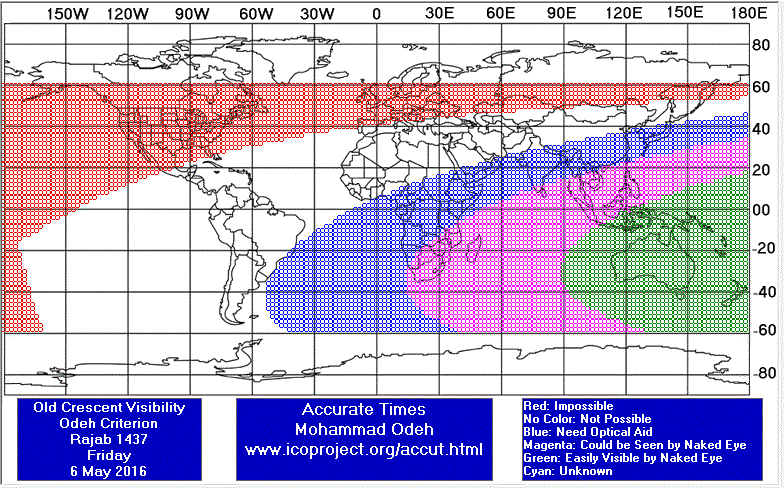
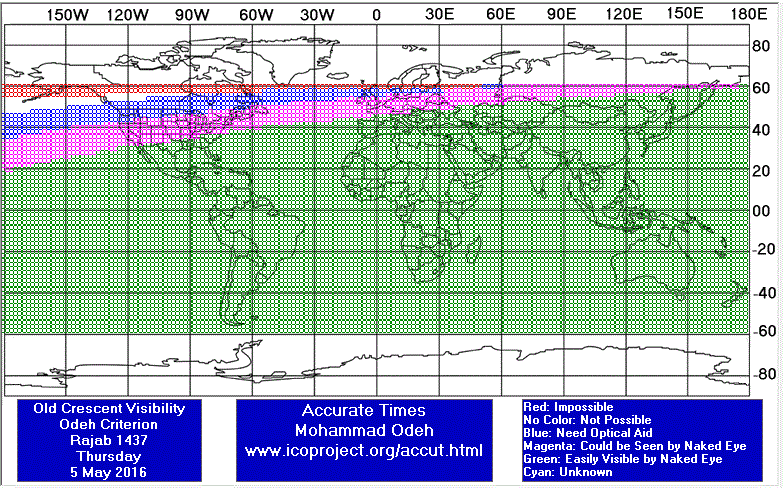
Rajab Waning (OLD) Crescent Observation Results
Thu 05 May 2016
Indonesia
Mr. AR Sugeng Riyadi said: "The old crescent of Rajab 1437 AH was seen from Assalaam Observatory, The Modern Boarding School of Islam ASSALAAM Pabelan Kartasura Sukoharjo Central Java Indonesia. The east sky was partly cloudy but the moon was easy seen by naked eye by Riztya Ahaddiyanti (East Borneo) and Diana Solicha (Palembang), both are the member of CASA (Club Astronomi Santri Assalaam). The moon also seen from my backyard at Bendo Ketitang Juwiring Klaten."
Fri 06 May 2016
Germany
Eng. Martin Elsaesser said: "As the moon only rose after sunset i could only observe it during the day. The weather was fine with very blue skies. The imaging system immediately showed a long crescent arc at 8° elongation, some two hours before noon. Due to the stable conditions i could do some experiments with different cameras and processing settings. The weather forcast for tomorrow looks fine, so i hope to be able to observe the moon soon after conjunction."
Indonesia
Mr. AR Sugeng Riyadi said: "The old daytime crescent of Rajab 1437 AH was seen by my friend (Muhammad Yusuf) from Bosscha Observatory, Lembang Bandung West Java Indonesia."
Mr. AR Sugeng Riyadi said: "The old crescent was not seen from Assalaam Observatory PPMI Assalaam Pabelan Kartasura Sukoharjo Central Java Indonesia, the horizon was cloudy and hazy."
Saudi Arabia
Mr. Turki Alamri said: "We arrived to alfegra me and khalecd alzaaq arround 2 pm lt clouds are present with strong haze and strong wind, we tried several times but can not see the crescent AOD 540 = 0.2"
